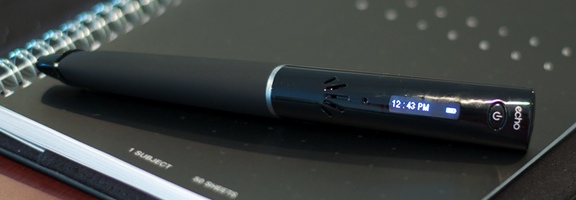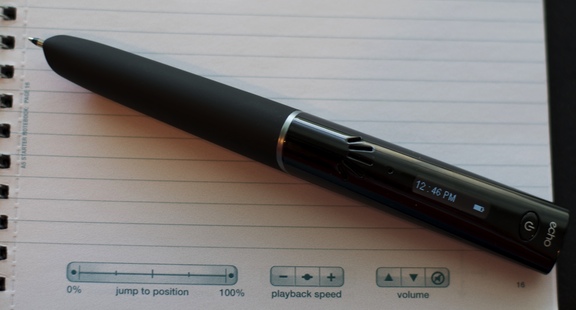Save and Sync Your Written and Spoken Word: Livescribe Echo Review

The Livescribe Echo is gadget that I've had my eye for some time now. It intrigued me, but I never felt a burning need to own one. A few weeks ago, though, I was contacted by a representive from Staples, the office supply store. Staples wanted to get the word out that it sells gadgets, and was offering to provide me with a product that it sells, for me to review and keep. After considering a few items, such as a scanner, printer, DSLR lens, or even a Synology NAS, I settled on the Livescribe Echo. I picked it because it was an item I might not have otherwise purchased for myself. Was it a good choice? Read on for my impressions.
What is the Livescribe Echo?
The Livescribe Echo is a "smartpen" that digitally records both audio and written word, via a microphone built into the shaft of the pen and a sensor near the tip. When used with specially formattted paper (either purchased, or printed yourself), you can plug your pen into your computer, and your writings will be transferred to your computer, almost as if you had scanned the paper itself. If you elected to record audio when writing, that will get transferred as well.
Peformance as a writing capture tool
If you already own a scanner, the Livescribe Echo is a bit of a luxury item when used just a writing capture tool. If you have a scanner, and save your notes that way, then the Echo will save you a few seconds with each scan. If you don't have a scanner yet, then the Echo could be a good alternative to a scanner, but only if your scanning needs are primarily to capture your written word, or if you also want to capture audio (more on that below). Even then, a scanner might be a better choice. However, one of the benefits of the pen that I've found over the past couple of weeks is that it does reduce the amount of loose paper I have floating around.
As a writing instrument, the pen isn't bad, but it's not great, either. I like the feel of it in my hand (I'm a fan of fat pens), but it doesn't flow when writing. It feels a bit grabby or scratchy on paper, like a slightly improved version of a felt-tip pen. I'm a fan of ballpoint pens because of how smooth they are when writing, so this was a bit of a disappointment.
My biggest complaint with the pen is that I can't get careless with it. By that, I don't mean that I constantly worry about it being stolen or broken (although, given the cost, that is a concern). Instead, what I mean is that I can't get careless when writing, or the pen might not accurately record my writing. I have had a few occassions where, after loading my pen data onto the computer, I've discovered that the pen has left gaps in my recorded strokes. This made my writing appear even worse than it already was. In essence, my letters were malformed when viewed on the computer on those few occasions, even when the ink on paper was legible. I've only had that happen on a few of occassions, but even that was enough to cause me to not completely trust the pen.
As mentioned above, you have to use special paper with the pen. The paper isn't prohibitively expensive (a 4 notebook pack is about $18), but if you use the pen for work, and you otherwise don't have to purchase your own regular paper, you might want to find out if your employer will supply the Livescribe paper. Otherwise, the costs of the pen could add up over time. You can print your own paper, but that doesn't seem like an efficient choice.
Performance as an audio capture tool
The big draw of this pen is its ability to capture audio that syncs with your writing. The audio part is optional – the special paper has a "record" button on it. Tap it, and the pen will record audio that it hears around it. You can play back that audio as with any other audio you might record in your life, but the "coolness" factor of the pen is that you can tap on any word that you've written, and the Livescribe will play back the audio that was recorded at the time you wrote that word.

Similar playback functionality is offered by a dedicated desktop app, after you sync your notes. Instead of tapping on words on paper with the pen, you click on text on your computer screen to hear the audio. The text turns green in the area that is currently playing in the audio.
Just as I have to be careful with my writing if I want my written words to be recorded accurately, I also have to be careful with how I hold the pen when it comes to the audio. If I hold it so that the microphone is pointing down, the sound of the pen scratching on paper drowns out any other audio. Even with the microphone oriented upward, I can still hear the sound of the pen writing on paper.
The Desktop App
To get full use out of the pen, you're going to want to use the desktop app. Within the app, you can browse your writings, and play back the audio of the writing. You can also set things up so that you can easily send your content out to other apps, such as Evernote, OneNote, Facebook, Google Docs, or email. For now, I've just kept everything in the dedicated app, although I can see myself sending material to Evernote in the future.
Should You Get One?
You should think hard about possible use cases for this pen before purchasing one. One of the benefits of the pen is that it would allow you to take spare notes, and go back and fill in detail later from the audio. For students, it is almost a no brainer if you take otherwise sparse notes, can afford one, and are in an environment where audio recording is permissible.
The same could be said for professionals who spend much of their time in meetings. Again, though, you have to be in an enviroment where recordings are allowed.
That, really, is the biggest problem for me. In my line of work, I can't imagine myself asking a client, especially a new one, if I can record a conversation (I'd never record it otherwise, since that would be illegal where I practice). Perhaps I would make the request and record the audio if I were dealing with a longstanding client in a very important meeting in a case, such as in an initial trial preparation meeting.
That makes the audio functionality of limited value to me. I have to really think hard about how I'd use it. In the comments section of his blog, Dan Gold gave me another idea for how to use the audio. He mentioned that he uses the audio when making notes himself, and thinking through issues aloud. I could see that being useful, although I imagine I'd get many funny looks from my coworkers.
The bottom line is that you have to think through how you would use a device like this. For me, the main use will be to bypass my scanner, and more quickly get my notes into digital form. Really, though, this just saves me a few seconds of scanning my notes. The pen will be great for some people, but others would do just fine with a nice scanner.
If you have some use cases for the pen, share those in the comments.
Thanks to Staples for providing the pen.
Here are some related posts that might interest you:
Original Page: http://feedproxy.google.com/~r/40tech/~3/ai-BOq0r_Mw/
Oliver Yatco

No comments:
Post a Comment